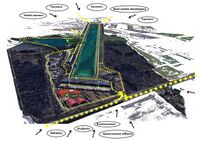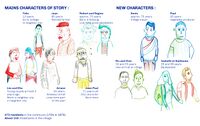LED2LEAP 2020 - Freising Team 3: Difference between revisions
| Line 115: | Line 115: | ||
= Phase B: Democratic Landscape Analysis and Assessment = | = Phase B: Democratic Landscape Analysis and Assessment = | ||
== The Scene in your Story of Analysis == | == The Scene in your Story of Analysis == | ||
*''Describe your landscape democracy challenge. What is the physical scene, specific description of the landscape? What are the socio-economic and political characteristics of place? Are there any important contextual elements?'' | *''Describe your landscape democracy challenge. | ||
Lack of marketing landscape through sustainable marketing-call for more social, cultural, and traditional responsibility and traffics and attraction. | |||
What is the physical scene, a specific description of the landscape? | |||
farms and agricultural land near Olympic rowing regatta course | |||
What are the socio-economic and political characteristics of place? Are there any important contextual elements? | |||
eco-tourism | |||
Socio-economic | |||
political characteristics of the place | |||
'' | |||
*''add the corresponding visual from your presentation to the image gallery below'' | *''add the corresponding visual from your presentation to the image gallery below'' | ||
Revision as of 07:55, 20 May 2020
>>>back to working groups overview
Landscape Democracy Rationale
- Why do you think this community context is relevant from a landscape democracy perspective? What is your hypothesis considering the landscape democracy challenges?
- Format: 3-4 sentences
Here are the sustainable Development Goals in which we can achieve: Sustainable cities and communities, Good health and well-being, Climate action, Decent work and Economic growth, Clean water and sanitation, Industry. innovation and infrustructure
Location and scope
- You can edit this map with the map editor
- Next to showing us where you are, you may also use this map to localise different focus themes of your community
Phase A: Mapping your Community
Welcome to your community and its landscape
The target of our map community located in Olympic rowing regatta course and its neighborhoods. socio-economic characteristics: Hotels, Restaurants, retail shops, a small airport, Munich airport. the issues that we are facing include: Lack of some conservation measures There are no public open spaces for community events. There is no land-use strategy for the surrounding land. Lack of strong relationships to apply different strategies (environmental, recreation, cultural, education, tourism, and marketing strategies) in this area. Lack of strength nature protection strategies.
Groups of actors and stakeholders in your community
- Which groups/sub-communities are there? Farmers, Hotel owners, Real estate developers, Athletes, Student, Businessmen, Government officers.
What are their needs and aspirations with regard to the landscape? expansion of the park as a Location with potentials for commercial investments and have a place that all other sport can use. There are nonvisible groups like environmentalists and the natural preservation committee will try to protect the areas. But, because of the power of local government and real estate agencies, these groups don't get enough space to protect the areas. Main challenges: • Protection of monumental • Protection for forests and natural environmental especially Habitat of wild animals, especially bluebirds • Need to renovate for Adapt to the environment while maintaining modern safety regulations • Keep infrastructure More visible group: Athletes and Commercial group, Less visible group: Environmental group and Farmers
Relationships between your actors and groups
- How would you describe the power relationship between the groups?
- Which groups may have shared interests and which are these?
Summary of your learnings from the transnational discussion panel on April 22
On April 22 you will present the PPT version of this first assignment to other seminar groups working in other geographical community contexts. Please give here a short summary of your learnings during this presentation, for example:
- Other analytical approaches
We learn the pivotal role of brainstorm of problems with using specific examples to support our ideas
- Other representation styles
Other representation style used of language, signs and images which stand for or represent things were in their work.
- Other value schemes: any surprises?
Art representation that had been used of its signs like hand sketch, which stand in for and take the place of something, was considered during presentation.
- Constructive comments we received on our presentation
We have to attention to ongoing plan or some future planning of development by government and authorities in area of case study which we did not think about it.
Theory reflection
- Reflect on at least three readings from the first section 'Democratic Landscape Transformation
- You can choose references from our reading list or suggest others
- Scope: 250 words
Went well: • Tourist can have positive impact on economy • Create area for international event and global fame • Providing job opportunity for local people • Regional development • People, tourist and government need to work more with each other
Difficult: • Tourist can have negative affect an environmental areas • Using up natural resources • Cultural degradation • Deprive the local population from their natural rights to use these resources
References
- give a full list of the references you have used for this section
https://www.leistungszentrum-muenchen.de/en/ https://www.openpetition.de/petition/online/munich-oberschleissheim-save-the-regatta
Phase B: Democratic Landscape Analysis and Assessment
The Scene in your Story of Analysis
- Describe your landscape democracy challenge.
Lack of marketing landscape through sustainable marketing-call for more social, cultural, and traditional responsibility and traffics and attraction.
What is the physical scene, a specific description of the landscape? farms and agricultural land near Olympic rowing regatta course
What are the socio-economic and political characteristics of place? Are there any important contextual elements?
eco-tourism Socio-economic
political characteristics of the place
- add the corresponding visual from your presentation to the image gallery below
- Yourcase scene1.jpg
add a caption
The Actors in your Story of Analysis
- Describe the characters and their role in the story. Are they major or minor characters? Are there any key relationships that need to be defined?
- add the corresponding visual from your presentation to the image gallery below
The Story of Analysis
- Describe the plot of the story and how it plays out.
- add the corresponding visual from your presentation to the image gallery below
- add as many additional images as you like
- Yourcase story2.jpg
add a caption
Reflect on your Story of Analysis
- How did the tools you chose for landscape analysis fit your community? Reflect on the questions: What did you carry? Why did you carry? How did you carry? What remains after you've left? (150 words)
- add the corresponding visual from your presentation to the image gallery below
- Yourcase refelction1.jpg
add a caption
Phase C: Collaborative Visioning and Goal Setting
* template coming
Phase D: Collaborative Design, Transformation and Planning
* template coming
Phase E: Collaborative Design, Transformation and Planning
* template coming
= Phase E: Collaborative Evaluation and Future Agendas * template coming
Process Reflection
- Reflect in your intercultural and interdisciplinary team on the outcomes of your study
- Which limitations were you facing?
- What have you learnt from each other?
- What would you do differently next time?
- You can also use diagrams/visuals
- 250 words text







